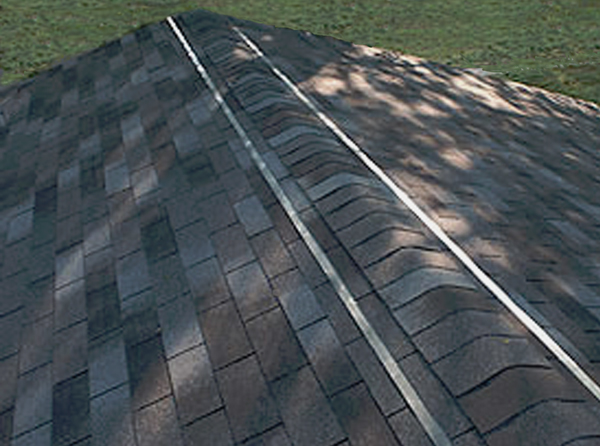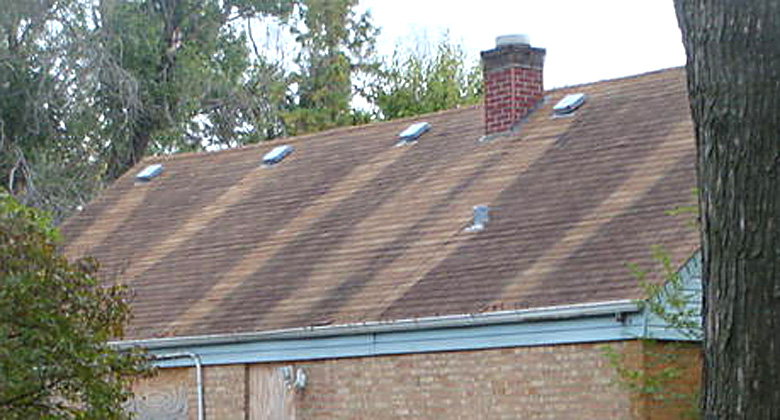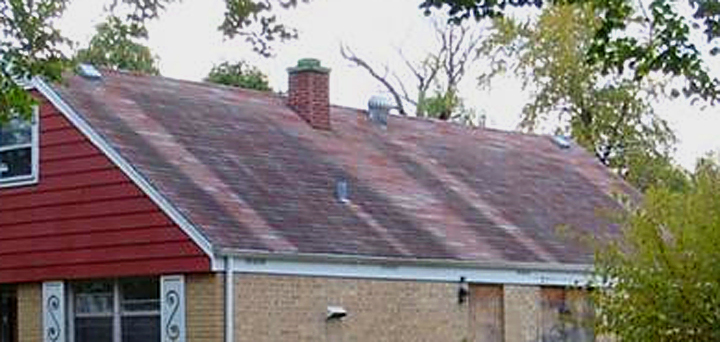I have heard this bandied about between roof cleaning companies and home inspectors and roofers. The fact is: it Does work. Zinc strips on your roof keep it looking new. The question is: for how long? Some say for 4 years, other claim up to 20+ years.
 Some of the examples pointed to by detractors of zinc strips, illustrate galvanized steel strips, which can rust after a few years. And the roof cleaning companies appear to be correct about those. However, the difference appears to be: there is zinc-plated (as in galvanized steel with a thin zinc coating: it’s the zinc that makes it “galvanized”) and there is nearly All zinc. There is a difference. Some zinc materials are made to be used on roofs for the specific purpose of keeping the roofs clean of mold, bacteria and other organic, growing things, that could otherwise darken and streak an asphaltic fiberglass shingle roof. Pure zinc seems to be very good at doing this.
Some of the examples pointed to by detractors of zinc strips, illustrate galvanized steel strips, which can rust after a few years. And the roof cleaning companies appear to be correct about those. However, the difference appears to be: there is zinc-plated (as in galvanized steel with a thin zinc coating: it’s the zinc that makes it “galvanized”) and there is nearly All zinc. There is a difference. Some zinc materials are made to be used on roofs for the specific purpose of keeping the roofs clean of mold, bacteria and other organic, growing things, that could otherwise darken and streak an asphaltic fiberglass shingle roof. Pure zinc seems to be very good at doing this.
There are superior zinc strips that can be approximately 99.5% pure zinc. These are not the same thing as a zinc-plated piece of steel. In the nearly pure zinc strips, some of the trace materials might be copper or even titanium. The zinc-plated (as in galvanizing) steel sheets are Not nearly pure zinc and these strips will likely begin to rust after the thin zinc coating wears in several years. Although, many galvanized coatings on rooftop equipment can and do last for decades sometimes, even with such mundane pieces of equipment as rooftop fans, vents through roofs (for plumbing), flashing around penetrations like chimneys and other apparatus.

To the left you can see old, boarded up houses, obviously older than 20 or 30 years, perhaps even 40 or 50 years or more older, and they have what appears to be original galvanized steel equipment on the roof. Here’s the interesting thing: the old roof has nasty, black, dirty streaks all over it (mold and other organic growth): Except exactly downslope of each of the rooftop galvanized (zinc-coated) pieces of equipment! This means that there is something in the residue of the zinc that washes off in rain water and condensation on it, that is toxic to organic growing material downstream of it on the roofing. This is interesting, in that zinc is used in foods and even vitamins for humans. This is because the free zinc ion in solution is highly toxic to plants, invertebrates and even vertebrate fish.
Only 6 micromolars of the zinc ion will kill 93% of Daphnia in water. The free zinc ion is a powerful Lewis acid including up to a corrosive level.

Zinc is a metallic chemical element, with the symbol Zn, with the atomic number of 30. It is the first element in the 12th group on the Periodic Table. It has some similarities to magnesium, as it has an ion of similar size and its common oxidation state is +2. Zinc is the 24th most abundant element in the Earth’s crust and has 5 stable isotopes.
The important thing to know is that using nearly pure zinc strips located very close to the ridge line of a residential roof, can keep the fiberglass and asphalt roof shingles below them essentially clean of mold and other organically growing “plants” & bacteria/algae. Some people have indicated that the effectiveness might be 20′, but we have not seen any precision in such estimates. As you will see on the posted photos, even galvanized coated (zinc coated) sheet steel in cheap roof components appears to continue to effectively keep the roof shingles clean for decades.
We are now indicating nearly pure zinc strips to be located just under our co-polymer ridge vents, with perhaps an inch or so exposed over the lower roof shingle below the ridge vent. This should successfully allow for free zinc ions to be washed in solution downslope and keep the majority of the fiberglass-asphalt roof shingle look clean, hopefully for a long time. Nearly pure zinc strips are relatively inexpensive: about $36 for a 50′ long strip about 2-1/2″ wide (per Zinc Shield literature 11/2011), check on today’s costs in your area. That’s 72 cents a linear foot, and if installed at the same time along with your continuous ridge vent, the added cost should be negligible. If you had 75′ of roof ridges, multiply x 2 (both sides of the ridge) = 150 x $0.72 = $108 for the material. Some of the detractors of zinc strips indicated that installing zinc strips was expensive; I am not sure where they got their information. Do Not use ordinary nails, which could cause electrolysis. Use the zinc nails you can obtain from the zinc strip manufacturer, although you may not need many, as if you are clamping the zinc strips under the lower edge of the ridge vents, the ridge vent will likely secure the top edge of the zinc strips.
One manufacturer claims that their 99%+ pure zinc strips will continue to function for 20+ years. That doesn’t sound like much of a gamble, and there is much to be gained for such a small investment. Some people have their roofs pressure washed to clean them and they should know that this seriously reduces the life of their asphaltic fiberglass roof shingles. Why? Because little stone granules are imbedded in the thin top layer of asphalt over the center fiberglass core. That is how fiberglass roof shingles are made.
The reason for the stone granules: to protect the asphalt from degrading in the raw sunlight. When you wash away the protective layer of stone granules, the thin layer of asphalt is exposed and degrades all the faster. So: no pressure washing! Something with near magical properties like these zinc strips is by far a better solution.
Be careful with copper gutters, however, the zinc solution can be corrosive to these, we have heard. We would suggest you monitor your gutter systems perhaps once a year, to see if they are performing cooperatively with the zinc. Installing these zinc strips BEFORE you have algae growth is preferred. The manufacturers of the zinc strips are not claiming to be a Mold Removal device, but rather, a preventative measure. Even so, We have seem compelling photos from some people testing this theory, and the zinc strips did in fact have a toxic effect on existing huge actual moss growth! The zinc also seems to work well on wood shingle roofs, like cedar.
Note: do Not install zinc strips with exposed nails on top of exposed roof shingles! You will be asking rain to leak through those exposed nail heads. That is why we specify the zinc strips to be tucked under the edge of the co-polymer ridge vents, which are nailed or screwed down to the roof deck, then have ridge shingles installed and overlapped over the ridge vents, giving a fairly watertight installation.
This is just one of the constantly increasing knowledge base systems of the custom residential architects at this architectural firm: 1 . 269 . 9046. www.HomeArchitects.com . We are always looking for and finding ways to make your house look better and last longer.
Links: Massachusetts Home Inspections , Contact Rand Soellner
